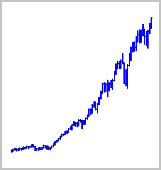 Menu
Menu
 Menu
Menu

Just after the stock market peak in 2000, there were a number of man-in-the-street interviews on television asking people what they thought about their investments. Typically the response was either a proud or resolute "I'm in it for the long term", which they had been trained by their advisors to believe was the only correct response. We wonder how many of those people continued to believe it at the market bottom in 2003 and still thought so at the 2009 nadir.
In our opinion at LFM&P, it is important for you to consciously know whether or not you are "in it" for the long (or short) term. While we may agree that it is important to be a long-term investor, we may differ from others about what that really means. Does it mean I should buy-and-hold, toughing out the down markets while my wealth shrivels? No. The answer is not that easy to state -- or that hard to bear.
To LFM&P it means several things:
1) Just as Rome was not built in a day, wealth that is likely to be retained is built slowly and through knowledge. Short-term luck has little value. Treating the investment markets as a get-rich-quick casino or lottery will produce losses like most casino and lottery experiences.
2) Before investing, it is wise to have a strategy that you believe will hold up over the long-term, one that considers the risks, and provides capital protection. It is important for you to have sufficient funds to be able to weather unexpected economic conditions like we have experienced and will do again.
Because investment values are volatile, investment assets should be chosen according to when you might need to draw on the money. You do not want to be forced remove investment funds on occasions when market values are low. Although market prices have always recovered eventually, money that has been removed does not have the opportunity to regain its value.
Investments that have provided the greatest return over time have also been the most volatile. You should be ready to commit to at least a five-year investment time frame for stock investments. This does not mean buy-and-hold for five years. It means that you should guard against having to make a forced liquidation of a stock allocation at the bottom of an economic cycle, which typically can occur every three to five years.
Just as stocks pay the highest returns and have the most volatility, long-term bonds typically yield more than short-term bonds and carry more volatility risk. Bonds have a measurement called "duration", which is related to the bond’s maturity and yield. You should try to make your bond investment duration approximately equal to the time when you will need the funds. The equivalent duration for stocks is more like 30-50 years. If your funds may be needed sooner than that time-frame, you should not invest those funds in stocks with a buy-and-hold strategy. You should target your investments for the short- or intermediate-term, including bonds, money market funds, treasury bills and certificates of deposit. Another option is to use a shorter-term tactical allocation strategy for stocks like LFM&P's MarketAwareSM.
If you have an investment plan that looks into the future, considers the risks involved, and commits funds for a period related to the risk being taken, you are, in fact, “in it for the long term”. If you think you are in it for the long term because you are following a buy-and-hold strategy and do not have sufficient reserve capital, you may unhappily find out that you are in it for a shorter term than you initially envisioned.
9-7